News Beat
News Beat reporting is an idrw.org initiative to let our Readers to report News Based on Actual facts but some how has not been reported in Main Stream Media .
SOURCE: RAUNAK KUNDE / NEWS BEAT / IDRW.ORG
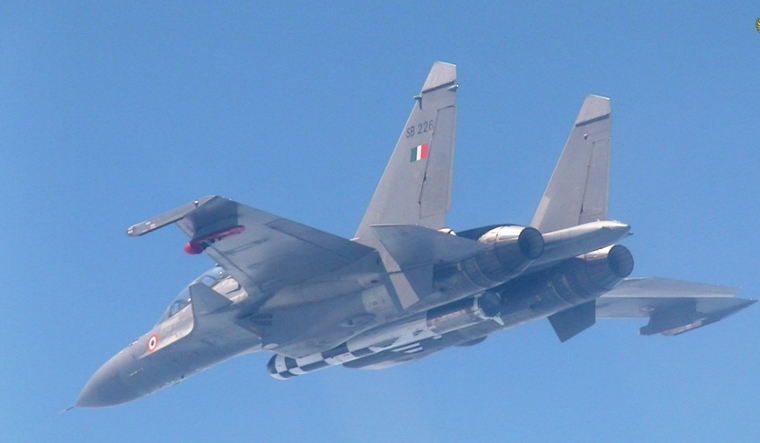
The Indian Air Force (IAF) is transforming a significant portion of its Su-30MKI fleet into powerful long-range strike platforms. With around 21 Su-30MKIs already modified to carry 2.5-ton Air Launched Cruise Missiles (ALCMs) like the BrahMos-A, and plans to make more aircraft BrahMos-A capable, the IAF is positioning itself for enhanced offensive capabilities.
An additional 19 Su-30MKIs are proposed to be upgraded for BrahMos-A compatibility, significantly boosting the IAF’s long-range strike power. By modifying and hardening these aircraft to carry ALCMs like the BrahMos-A, India gains a significant edge in the maritime domain.
Continue readingSOURCE: RAUNAK KUNDE / NEWS BEAT / IDRW.ORG
The Indian Air Force’s (IAF) quest for a robust Airborne Warning and Control System (AWACS) capability continues to gain momentum. While the Netra Mk1A and Airbus A-321-based AEW&C MkII programs are currently in the spotlight, DRDO, India’s premier defence research organization, hasn’t lost sight of the long-term goal – a dome-mounted AWACS solution offering complete 360-degree coverage.
According to informed sources close to idrw.org, DRDO is actively pursuing the development of a dome antenna specifically designed for the AWACS program. This ongoing effort comes despite the current focus on the Netra Mk1A and AEW&C MkII projects.
Continue readingSOURCE: RAUNAK KUNDE / NEWS BEAT / IDRW.ORG

GE Aerospace is set to increase investments in its F-404 engine production line in anticipation of significant orders from both India and the United States. This move comes as India finalizes a deal for additional Tejas Mk1A fighter jets, each powered by the F404-IN20 engine variant.
The investment will focus on new tooling, refurbishment of existing machinery, and the acquisition of additional equipment. This will specifically target the production of F-404 engine blades and vanes, critical components for achieving optimal engine performance.
Continue readingSOURCE: RAUNAK KUNDE / NEWS BEAT / IDRW.ORG

India’s next-generation anti-submarine warfare (ASW) capabilities are set to receive a significant boost with the Supersonic Missile-Assisted Release of Torpedo (SMART) system. Developed by the Defence Research and Development Organisation (DRDO), SMART is designed to be integrated into the Indian Navy’s existing anti-submarine warfare corvettes.
SMART employs a supersonic missile to carry a lightweight, electrically-propelled torpedo known as the Torpedo Advanced Light (TAL). This innovative system offers a crucial advantage: extended range. Unlike conventional torpedoes with limited reach, SMART can engage enemy submarines from hundreds of kilometres away, significantly expanding the Indian Navy’s ASW zone.
Continue readingSOURCE: RAUNAK KUNDE / NEWS BEAT / IDRW.ORG
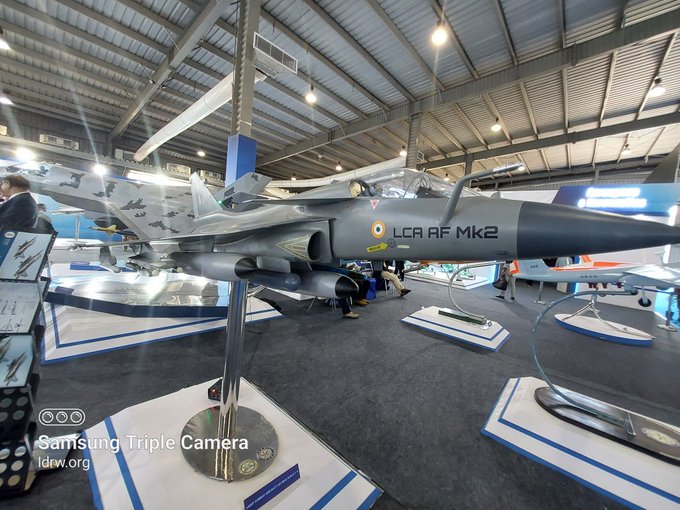
The development of the indigenous Light Combat Aircraft (LCA) Tejas Mk2 is taking a significant step forward with the introduction of an Ironbird facility. This hardware-in-loop (HIL) testing environment plays a crucial role in evaluating the aircraft’s Integrated Flight Control System (IFCS) before actual flight testing commences.
As per tenders accessible by idrw.org, ADA plans to start testing many of the key systems of the Tejas MkII program soon on the Ironbird Facility. ADA is planning to test onboard computers like the Digital Flight Control Computer (DFCC), Auxiliary Computer (AC), and Mission Management and Display Computer (MMDC) to generate a vast amount of data.
Continue readingSOURCE: RAUNAK KUNDE / NEWS BEAT / IDRW.ORG

India’s Defence Research and Development Organisation (DRDO) successfully test-fired the Supersonic Missile-Assisted Release of Torpedo (SMART) system on May 1st, 2024, from Dr. APJ Abdul Kalam Island off the coast of Odisha. This next-generation system promises to significantly enhance the Indian Navy’s anti-submarine warfare capabilities.
SMART is a canister-based missile system designed to deliver a lightweight torpedo over long distances. It boasts a two-stage solid propulsion system, an electromechanical actuator system, and a precision inertial navigation system for accurate targeting. The system also features a parachute-based release mechanism for the torpedo payload.
Continue readingSOURCE: RAUNAK KUNDE / NEWS BEAT / IDRW.ORG
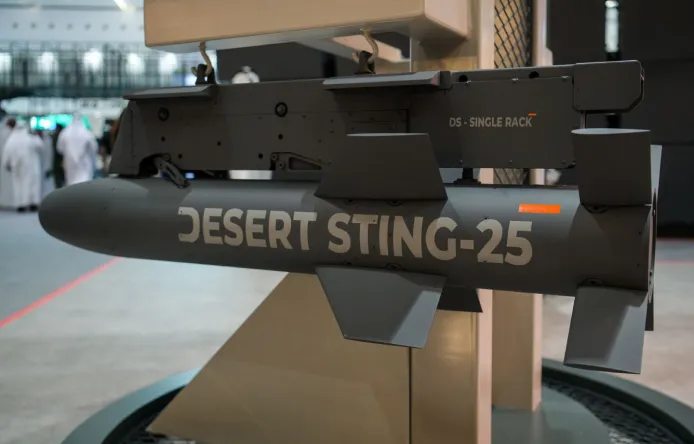
EDGE Group, a leading defence technology conglomerate from Abu Dhabi, is making a concerted effort to solidify its presence in the Indian defence market. Following their proposal of the AL TARIQ smart weapon with a technology transfer option for the LCA-Tejas Mk1A fighter jet program, EDGE has now set its sights on fulfilling India’s aerial weapon needs with the DESERT STING 25 Guided-Glide Weapon.
The DESERT STING 25 is a family of lightweight, air-launched, precision-guided weapons designed for maximum impact. These weapons are ideal for integration with unmanned aerial vehicles (UAVs), particularly India’s Archer-NG and Archer-SRUAV programs.
Continue readingSOURCE: RAUNAK KUNDE / NEWS BEAT / IDRW.ORG
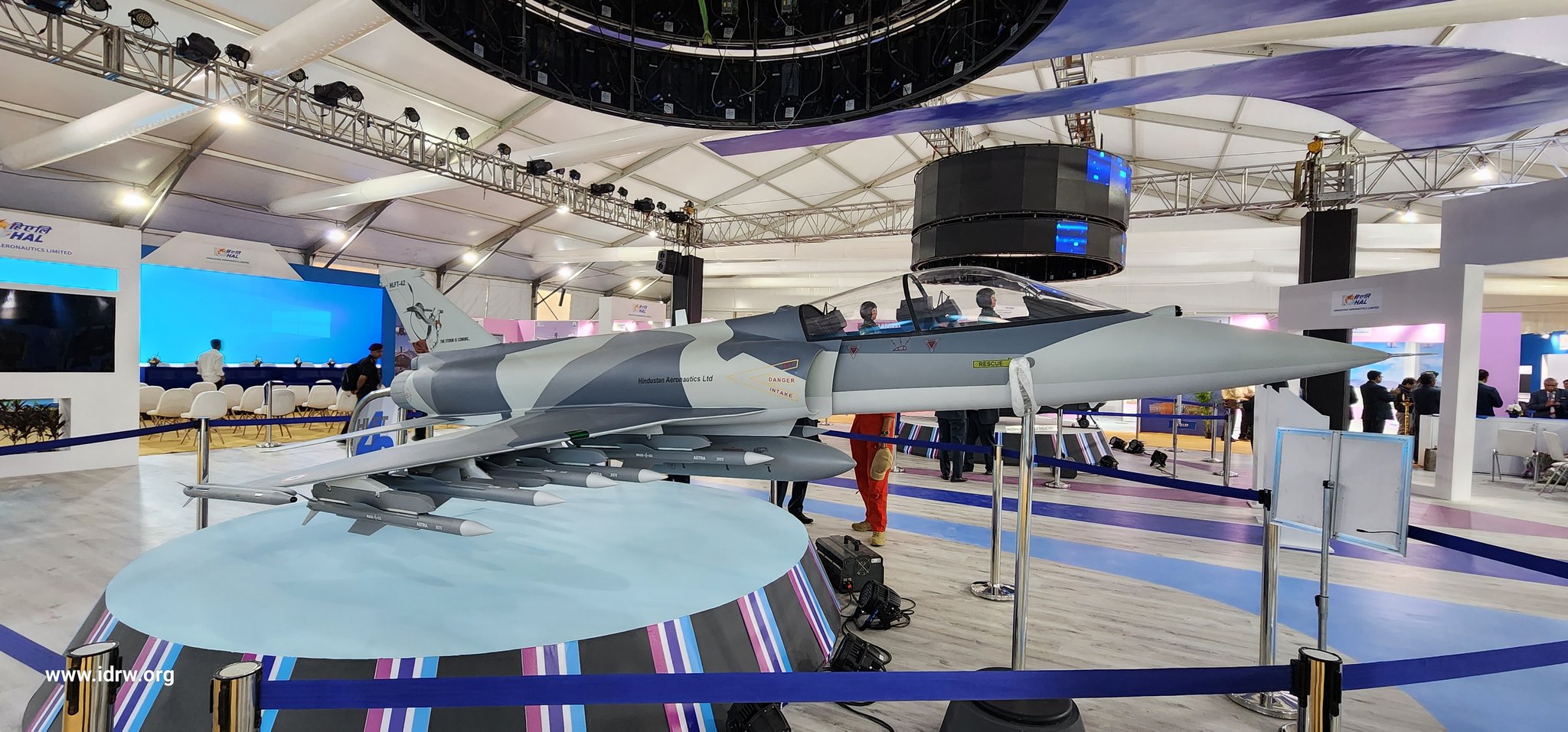
Hindustan Aeronautics Limited’s (HAL) ambitious HLFT-42 program, unveiled in 2023 as the “Next Gen Supersonic Trainer,” seems to be facing delays. While the initial reveal showcased a promising design with a 4.5-ton weapon payload and the ability to act as a light combat jet, crucial decisions regarding final configuration and engine selection remain unresolved.
The HLFT-42 captured attention with its impressive capabilities. Boasting a 4.5-ton weapon payload capacity and a 16.5-ton Maximum Take-Off Weight (MTOW), it promised to not only provide advanced pilot training for 4th and 5th-generation fighters but also function as a light combat jet. This versatility, coupled with the potential for combat teaming scenarios, made it an attractive proposition for the Indian Air Force (IAF).
Continue readingSOURCE: RAUNAK KUNDE / NEWS BEAT / IDRW.ORG
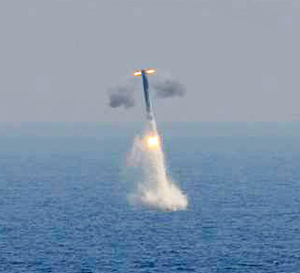
On March 20, 2013, India witnessed a historic feat: the successful test-fire of a submarine-launched BrahMos (SLCM) supersonic cruise missile from a submerged platform in the Bay of Bengal. This marked a significant step forward in India’s underwater deterrence capabilities. However, over a decade later, the SLCM variant remains absent from operational Indian submarines.
The BrahMos, a joint Indo-Russian venture, boasts impressive range and speed. While the initial SLCM variant tested in 2013 had a range of 290 km, BrahMos Corporation has since developed even longer-range variants: the BrahMos-ER (450 km) and even a very longer version exceeding 800 km. Integrating these missiles with submarines would offer an unmatched underwater stand-off capability.
Continue readingSOURCE: RAUNAK KUNDE / NEWS BEAT / IDRW.ORG

Airbus is set to showcase its military muscle at India’s upcoming mega-exercise, ‘Tarang Shakti,’ in a bid to win key Indian Air Force (IAF) contracts. The European aerospace giant will demonstrate its A400M military transport aircraft, a contender for the IAF’s ambitious program to acquire 60-80 Medium Transport Aircraft (MTA).
The A400M demonstration, taking place alongside the exercise in Tamil Nadu this August, presents a unique opportunity for Airbus to impress IAF officials. Notably, the German Air Force, a participant in Tarang Shakti, will be deploying Tornado jets, Eurofighters, and Airbus A330 mid-air refuelling tankers – all platforms that Airbus is also actively pushing for IAF consideration. The Eurofighter is a competitor in the IAF’s MRFA tender for new fighter jets, while the A330 competes for the IAF’s requirement of six mid-air refuelling tankers.
Continue readingSOURCE: RAUNAK KUNDE / NEWS BEAT / IDRW.ORG

Yantra India Limited (YIL), a major Indian state-owned defence production company, is experiencing a surge in demand for its 155mm artillery shells. This positive development is driven by a growing export market, propelling YIL towards significant production growth.
YIL has strategically scaled up its production of 155mm shells to cater to the rising demands of international buyers. This shift comes in stark contrast to the past, where YIL typically received yearly domestic indents for a considerably lesser quantity (around 50,000 to 60,000 shells).
Continue readingSOURCE: RAUNAK KUNDE / NEWS BEAT / IDRW.ORG

India’s state-owned Hindustan Aeronautics Limited (HAL) is set to test a new Obstacle Avoidance System (OAS) for its indigenously developed Light Combat Helicopter (LCH) Prachand. This system will provide a crucial safety upgrade for pilots, particularly during low-level flight manoeuvres.
Attack helicopters like the Prachand excel at low-level flying maneuvers, making them ideal for taking out armored regiments. However, this operational environment also presents unique challenges. Pilots must navigate a complex landscape filled with obstacles like hills, towers, power lines, and cableways. These threats become even more dangerous during bad weather conditions and low-visibility situations like night missions.
Continue readingSOURCE: RAUNAK KUNDE / NEWS BEAT / IDRW.ORG

The long-awaited dream of DRDO (Defence Research and Development Organisation) and HAL (Hindustan Aeronautics Limited) to establish an indigenous climate chamber test facility for fighter jets appears to be nearing fruition. This facility will be a game-changer for India’s domestic fighter jet development, offering a multitude of advantages:
Climate chambers can simulate a wide range of weather conditions, from scorching deserts to frigid high altitudes. This eliminates the need for time-consuming and expensive relocation of test jets to geographically diverse locations. Faster testing translates to quicker development cycles and earlier deployment of advanced fighter jets for the Indian Air Force.
Continue readingSOURCE: RAUNAK KUNDE / NEWS BEAT / IDRW.ORG

India is poised to take a significant leap in its military capabilities with the ambitious development of its own Unmanned Combat Aerial Vehicles (UCAVs), also known as stealth combat drones. These drones, envisioned to fire missiles and precision-guided weapons, will offer a transformative edge in modern warfare.
While details remain under wraps, sources close to idrw.org suggest a funding proposal for the RPAS (Remote Piloted Aerial Vehicle) program, which encompasses UCAVs, could be presented later this year or early next year. Estimates suggest a potential budget of ?5,000 crore (approximately $600 million) to propel this program forward. Currently, the project is undergoing evaluation by a dedicated committee established by the Ministry of Finance.
Continue readingSOURCE: RAUNAK KUNDE / NEWS BEAT / IDRW.ORG
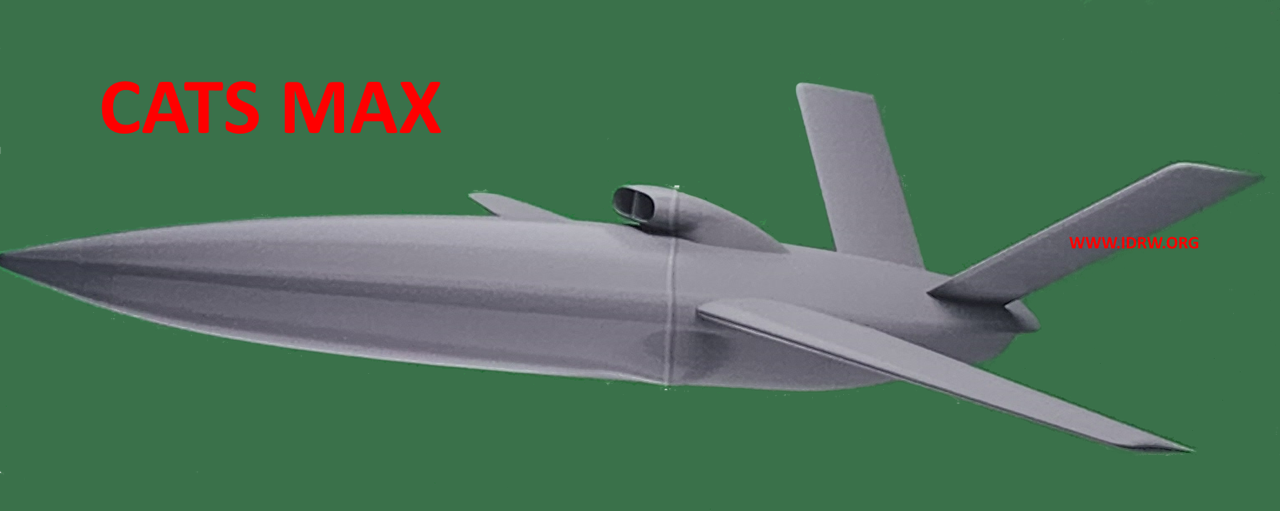
The Indian Air Force (IAF) and Hindustan Aeronautics Limited (HAL) are collaborating on a revolutionary project: the CATS-Warriors, a low-cost, highly capable unmanned combat aerial vehicle (UCAV). This “loyal wingman” concept has the potential to redefine aerial warfare strategies.
In 2019, the seeds were sown for this innovative project with the development of a proof-of-concept prototype. These 1.6-tonne marvels boast low observability (stealth) capabilities and autonomous flight at high altitudes (around 36-40,000 feet). The estimated unit cost of a mere ?50 crore (approximately $6.7 million) makes them incredibly cost-effective compared to traditional fighter jets.
Continue reading